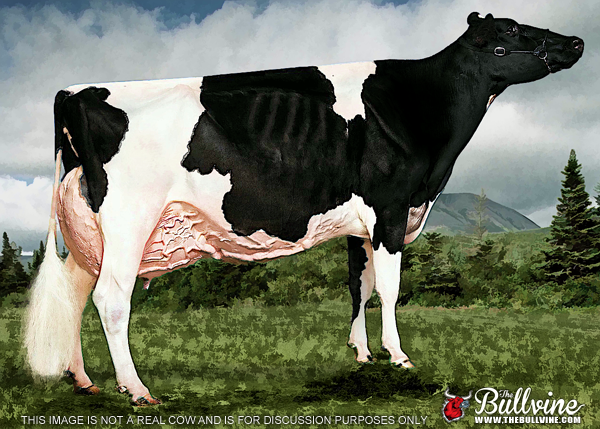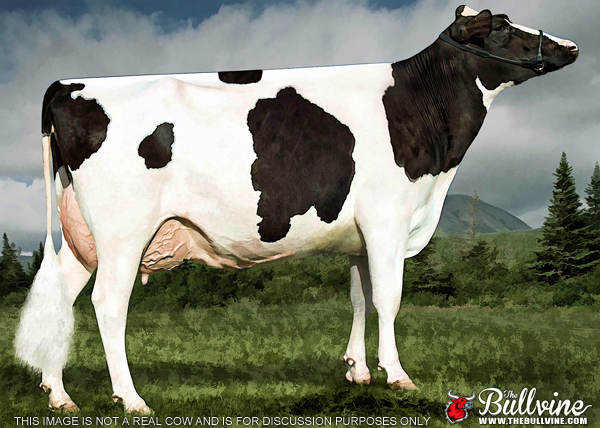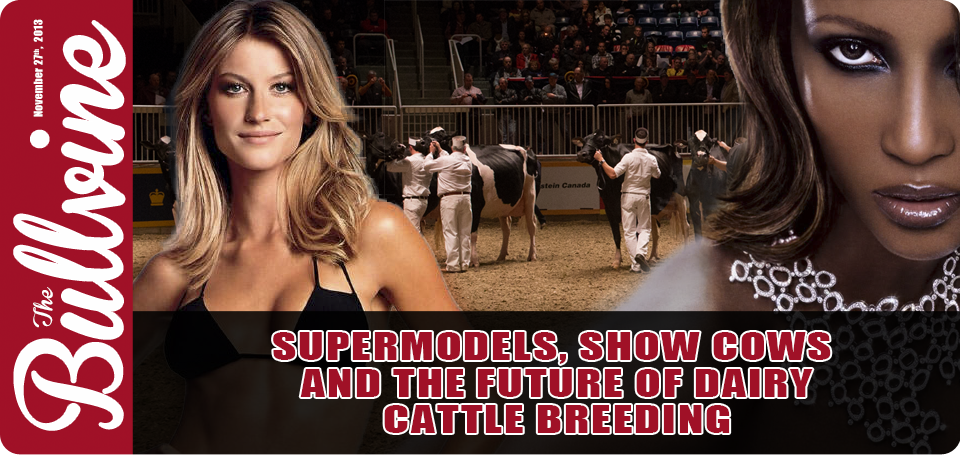Iman, Giselle, Claudia, Hailey, Frosty, and Charity….What do they all have in common? Besides that they are all so famous that they are recognizable by just one name, they are also famous for something else …their exceptional beauty. In the same way that supermodels are perceived to be the “perfect” woman, great show cows are often perceived to be the “ideal” cow. The problem is that, in the real world that may not be the case and, in fact, might be doing some breeders more harm than good.
You see, when we talk about ideal conformation of a cow, we look for many of the same things that we do in a supermodel. We want them to be long and skinny, unblemished and perfectly proportioned. The problem is, when you are looking for the perfect production cow, many of those traits may be detrimental to their ability to be a low maintenance, high performance animal.
The image of an ideal cow was one that was developed for a milk production system that was geared around one on one care of each animal, typically in tie stall. In that environment, you have the ability to work extensively with each animal and the time to do whatever it takes. The reality is that 85% of the milk that is produced these days happens in environments that are not able to give that level of individualized care.

The Bullvine Holstein Mature Model Cow
Tall, long, skinny works great on the runway, but not in a commercial milk production facility. These girls are high maintenance. They require lots of extra attention in order to look this great. That is something that milk producers cannot afford when, in reality, they are looking for the exact opposite. (Read more: FACT VS. FANTASY: A Realistic Approach to Sire Selection and The Perfect Holstein Cow)

The Bullvine Total Performance 2 Yr Old Cow
You see each milk producer’s ideal cow will be different. That is because their production facilities are different and, as a result, the cows that excel in those facilities will be different. (Read more: Are Today’s Holstein Cows Too Tall?) A great example of this is a robotic system versus a tie stall. While a breeder in a tie stall environment strives for taller, longer and wider, these traits may actually cause problems for some robotic systems. Sure you can always make the robots bigger, but what happens for those breeders who cannot afford to be continually upgrading? Instead these producers are more concerned about teat placement, calving ease and temperament. These traits typically do not find their way onto the radar of breeders who are looking to breed the next World Dairy Expo or Royal Grand Champion. (Read more: Robotic Milking: More than just automation it’s a new style of herd management)
Significant differences in production environments are the biggest reason that the gap is widening between what the typical seed stock producer considers the ideal cow and what the commercial producer’s ideal cow looks like. . This is occurring despite breed associations’ attempts to narrow the gap. The reality is there are so many different requirements with each different production environment that one breeder’s definition of the ideal cow can be very different from another’s. It also begs the question “Is there really such a thing as an ideal cow anymore?”
In fact there are many mindset differences among breeders who derive their revenue from different sources. You see it’s understandable that producers who make a significant portion of their income from selling seed stock would be more concerned about how the animal looks. These producers usually have qualifiers like, she has to be over 2 points for type (+10 Conformation in Canada), while many commercial producers could care less about using type as a qualifier for sire selection. A great example of this is Don Bennink from North Florida Holsteins. (Read more: NORTH FLORIDA HOLSTEINS. Aggressive, Progressive and Profitable!! ) Don points out that “Bulls with + 3 and + 4 type proofs have daughters that are too big and too sharp for commercial dairymen. For this reason gTPI or TPI are essentially ignored in bull or female selection. Net Merit $ has some value.” The latest correlation of final type score with stature is .77. Worse yet, the correlation of udder composite with stature is .57. That means if you breed 100% for udder composite, you will increase stature at more than half the rate that you would if you bred for stature alone. That is one of the reasons that Don does not even look at conformation when he is making sire selection. Instead he chooses the following qualifiers: 60 pounds or more of protein; 5 or above for P.L.; 1 or above for DPR; 2.9 or less for SCC; 5. 8 or below for Calving Ease. Interestingly enough when you apply these requirements you will find that the top 30 sires that meet them are between +1.50 and +4.00 for PTAT, have strong udders, positive feet and leg scores, and, probably, are not as tall or as wide chested and deep bodied as some of your typical high type sires, but they possess functional type.
Just like super skinny supermodels, when a cow is extremely underweight, it can cause many reproductive issues. First a cow’s menstrual cycle often stops or becomes irregular when she is too skinny. While that typically does not cause as many problems in yearlings and 2 year olds, as a cow gets older this can make it harder and harder to get them back in calf. Not only is it harder for underweight cows to conceive, it’s also harder for them to sustain the pregnancy, as menstrual irregularities affect the uterine lining that supports a fetus.
The Bullvine Bottom Line
Great show cows are like having a supermodel on your arm. They are eye candy pure and simple. Don’t get me wrong, I love to look at and take photos of a great show cow. And guess what? Showing a great show cow makes you look good as well. It’s not just self-aggrandizement either. There’s no shame in feeling proud of breeding or exhibiting the greatest looking cow at the show. It takes significant effort to exhibit a great show cow, so when it pays off, more power to you. The pitfall is that these great cows are also typically high maintenance. While that may not be an issue for your business, for most commercial producers it simply does not work!
Get original “Bullvine” content sent straight to your email inbox for free.
[related-posts-thumbnails]



















Leave a Reply
You must be logged in to post a comment.